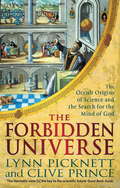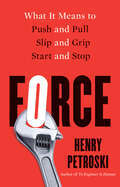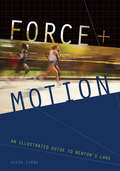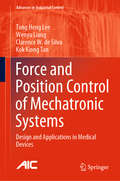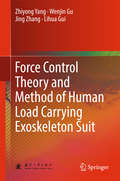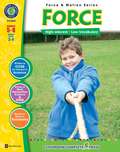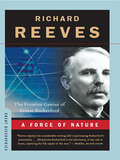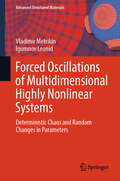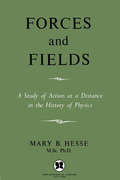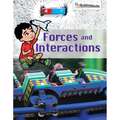- Table View
- List View
The Forbidden Universe: The Occult Origins Of Science And The Search For The Mind Of God
by Lynn Picknett Clive PrinceWere the first scientists hermetic philosophers? What do these occult origins of modern science tell us about the universe today? The Forbidden Universe reveals the secret brotherhood that defined the world, and perhaps discovered the mind of God.All the pioneers of science, from Copernicus to Newton via Galileo, were inspired by Hermeticism. Men such as Copernicus, Galileo, Newton, Leibniz, Bacon, Kepler, Tycho Brahe - even Shakespeare - owed much of their achievements to basically occult beliefs - the hermetica. In this fascinating study, Lynn Picknett and Clive Prince go in search of the Hermetic origins of modern science and prove that not everything is as it seems and that over the past 400 years there has been a secret agenda behind our search for truth. From the age of Leonardo da Vinci, the influence of hermetic thinking upon the greatest minds in history has been hidden, a secret held by a forbidden brotherhood in search of the mind of God. Yet this search does not end in history but can be found in the present day - in the contemporary debates of leading evolutionists and thinkers. The significance of this hidden school can hardly be over-emphasised. Not only did it provide a spiritual and philosophical background to the rise of modern science, but its worldview is also relevant to those hungry for all sorts of knowledge even in the twenty-first century. And it may even show the way to reconciling the apparently irreconcilable divide between the scientific and the spiritual. Picknett and Prince go in search of this true foundation of modern rational thought and reveal a story that overturns 400 years of received wisdom.
The Forbidden Universe: The Occult Origins of Science and the Search for the Mind of God
by Lynn Picknett Clive PrinceWere the first scientists hermetic philosophers? What do these occult origins of modern science tell us about the universe today? The Forbidden Universe reveals the secret brotherhood that defined the world, and perhaps discovered the mind of God.All the pioneers of science, from Copernicus to Newton via Galileo, were inspired by Hermeticism. Men such as Copernicus, Galileo, Newton, Leibniz, Bacon, Kepler, Tycho Brahe - even Shakespeare - owed much of their achievements to basically occult beliefs - the hermetica. In this fascinating study, Lynn Picknett and Clive Prince go in search of the Hermetic origins of modern science and prove that not everything is as it seems and that over the past 400 years there has been a secret agenda behind our search for truth. From the age of Leonardo da Vinci, the influence of hermetic thinking upon the greatest minds in history has been hidden, a secret held by a forbidden brotherhood in search of the mind of God. Yet this search does not end in history but can be found in the present day - in the contemporary debates of leading evolutionists and thinkers. The significance of this hidden school can hardly be over-emphasised. Not only did it provide a spiritual and philosophical background to the rise of modern science, but its worldview is also relevant to those hungry for all sorts of knowledge even in the twenty-first century. And it may even show the way to reconciling the apparently irreconcilable divide between the scientific and the spiritual. Picknett and Prince go in search of this true foundation of modern rational thought and reveal a story that overturns 400 years of received wisdom.
Force: What It Means to Push and Pull, Slip and Grip, Start and Stop
by Henry PetroskiAn eminent engineer and historian tackles one of the most elemental aspects of life: how we experience and utilize physical force &“Another gem from a master of technology writing.&”—Kirkus Reviews Force explores how humans interact with the material world in the course of their everyday activities. This book for the general reader also considers the significance of force in shaping societies and cultures. Celebrated author Henry Petroski delves into the ongoing physical interaction between people and things that enables them to stay put or causes them to move. He explores the range of daily human experience whereby we feel the sensations of push and pull, resistance and assistance. The book is also about metaphorical force, which manifests itself as pressure and relief, achievement and defeat. Petroski draws from a variety of disciplines to make the case that force—represented especially by our sense of touch—is a unifying principle that pervades our lives. In the wake of a prolonged global pandemic that increasingly cautioned us about contact with the physical world, Petroski offers a new perspective on the importance of the sensation and power of touch.
Force and Motion: An Illustrated Guide to Newton's Laws
by Jason ZimbaIsaac Newton developed three laws of motion that govern the everyday world. These laws are usually presented in purely mathematical forms, but Jason Zimba breaks with tradition and treats them visually. This unique approach allows students to appreciate the conceptual underpinnings of each law before moving on to qualitative descriptions of motion and, finally, to the equations and their solutions.Zimba has organized the book into seventeen brief and well-sequenced lessons, which focus on simple, manageable topics and delve into areas that often cause students to stumble. Each lesson is followed by a set of original problems that have been student-tested and refined over twenty years. Zimba illustrates the laws with more than 350 diagrams, an innovative presentation that offers a fresh way to teach the fundamentals in introductory physics, mechanics, and kinematics courses.
Force and Motion Engineering Internship, Engineering Notebook with Article Compilation
by Lawrence Hall of ScienceHow can you get critical supplies to people in need after a natural disaster? If you drop a pod of supplies, what pod materials and features will make safe and successful delivery of food and medical supplies? That’s what you will figure out as you and your classmates take on the role of mechanical engineering interns with Futura Engineering, a company that specializes in designing solutions for the world’s problems. As an intern, you will work to apply your knowledge of forces and motion to help design a pod that will deliver emergency aid packages to people in remote areas where disasters such as earthquakes, landslides, or floods have made it dangerous or impossible to deliver aid by trucks. You will design and test your pod using a digital tool called SupplyDrop, and consider different design aspects: the pod’s shell material, the type and amount of internal padding, and whether you will add additional external features like a parachute or landing legs to your pod. Your supply pod design must protect the cargo by minimizing damage to supplies, offer possibilities for reusing the pod’s shell for shelter, and be as low-cost as possible.
Force and Motion Resources: Images,Data and Readings
by FOSS Middle School Staff AssociatesScience Textbook
Force and Position Control of Mechatronic Systems: Design and Applications in Medical Devices (Advances in Industrial Control)
by Tong Heng Lee Wenyu Liang Clarence W. de Silva Kok Kiong TanForce and Position Control of Mechatronic Systems provides an overview of the general concepts and technologies in the area of force and position control. Novel ideas and innovations related to this area are presented and reported in detail, and examples of applications in medical technology are given.The book begins by introducing force sensing, and modelling of contacting objects. In then moves steadily through a variety of topics, including:• disturbance observer-based force estimation;• force-based supervisory control;• stabilization systems;• controller design; and• control of tube insertion procedures.This book will be of interest to researchers, engineers and students interested in force control, particularly those with a focus on medical applications of these ideas.Advances in Industrial Control reports and encourages the transfer of technology in control engineering. The rapid development of control technology has an impact on all areas of the control discipline. The series offers an opportunity for researchers to present an extended exposition of new work in all aspects of industrial control.
Force Control Theory and Method of Human Load Carrying Exoskeleton Suit
by Zhiyong Yang Wenjin Gu Jing Zhang Lihua GuiThis book reports on the latest advances in concepts and further development of principal component analysis (PCA), discussing in detail a number of open problems related to dimensional reduction techniques and their extensions. It brings together research findings, previously scattered throughout many scientific journal papers worldwide, and presents them in a methodologically unified form. Offering vital insights into the subject matter in self-contained chapters that balance the theory and concrete applications, and focusing on open problems, it is essential reading for all researchers and practitioners with an interest in PCA
Force (Force & Motion)
by George GraybillThis books provides ready-to-use information and activities for remedial students in grades five to eight. Written to grade using simplified language and vocabulary, science concepts are presented in a way that makes them more accessible to students and easier for them to understand. Comprised of reading passages, student activities and overhead transparencies, our resource can be used effectively for whole-class, small group and independent work.
Force Majeure in the Hydropower Industry: Concepts and Case Studies
by Daniel Constantin DiaconuThis book aims to highlight the particular situation faced by certain hydropower companies by the fact that they cannot fulfil their contracts due to force majeure. The first part of this book will be an analysis of how water is used in electricity production. It is important to point out that all types of energy sources use water, to a different extent, of course, and that its spatial and temporal availability is very important. The focus will be on hydropower, presenting the current situation at the global level, and the effect of reducing the amounts of water in the river system.The second part is based on the presentation of the concept of force majeure and the ways of presenting and drafting it in a contract. Many disputes or the success of a contract depended heavily on the provisions of this article of the contract. Obviously, there are also situations in which the signatory parties abuse or are not protected by these provisions of force majeure. Starting from a few brief examples from the international level, we reach a wide discussion of the situation created in Romania, when the largest supplier of electricity produced on the basis of water terminates several contracts invoking force majeure. The manner in which the opinion of the parties involved is presented to the court is analyzed and presented in detail.
Force, Motion, and Energy
by Uri Haber-Schaim Reed Cutting H. Graden Kirksey Harold A. Pratt Robert D. StairForces <p><p> Pressure <p> Forces Acting in Different Directions <p> Distance, Time, and Speed <p> Waves <p> Heating and Cooling <p> Potential Energy and Kinetic Energy
Force, Motion, and Work: Module K
by Leonard Bernstein Martin Schachter Alan Winkler Stanley WofeScience textbook
The Force of an Idea: New Essays on Christian Wolff's Psychology (Studies in History and Philosophy of Science #50)
by Saulo de Freitas Araujo Thiago Constâncio Ribeiro Pereira Thomas SturmThis book presents, for the first time in English, a comprehensive anthology of essays on Christian Wolff's psychology written by leading international scholars. Christian Wolff is one of the towering figures in 18th-century Western thought. In the last decades, the publication of Wolff's Gesammelte Werke by Jean École and collaborators has aroused new interest in his ideas, but the meaning, scope, and impact of his psychological program have remained open to close and comprehensive analysis and discussion. That is what this volume aims to do. This is the first volume in English completely devoted to Wolff's efforts to systematize empirical and rational psychology, against the background of his understanding of scientific method in metaphysics. Wolff thereby paved the way to the very idea of a scientific psychology. The book is divided into two parts. The first one covers the theoretical and historical meaning and scope of Wolff's psychology, both in its internal structure and in its relation to other parts of his philosophical system, such as logic, cosmology, aesthetics, or practical philosophy. The second part deals with the reception and impact of Wolff's psychology, starting with early reactions from his disciples and opponents, and moving on to Kant, Hegel, and Wundt. The Force of an Idea: New Essays on Christian Wolff's Psychology shows not only that Wolff's psychological ideas have been misinterpreted, but also that they are historically more significant than traditional wisdom has it. The book, therefore, will be of interest to historians and philosophers of science, historians of philosophy and psychology, as well as to philosophers and psychologists interested in understanding the roots of scientific psychology in 18th and 19th century German philosophy.
A Force of Nature: The Frontier Genius of Ernest Rutherford (Great Discoveries) (Great Discoveries #0)
by Richard Reeves"Starred Review. Reeves deploys his considerable writing skill in portraying Rutherford's personality ... capturing the full aspect of the man."--Booklist Born in colonial New Zealand, Ernest Rutherford grew up on the frontier--a different world from Cambridge, to which he won a scholarship at the age of twenty-four. His work revolutionized modern physics. Among his discoveries were the orbital structure of the atom and the concept of the "half-life" of radioactive materials. Rutherford and the young men working under him were the first to split the atom, unlocking tremendous forces--forces, as Rutherford himself predicted, that would bring us the atomic bomb. In Richard Reeves's hands, Rutherford comes alive, a ruddy, genial man and a pivotal figure in scientific history.
The Force of the Virtual: Deleuze, Science, and Philosophy
by Peter GaffneyGilles Deleuze once claimed that &‘modern science has not found its metaphysics, the metaphysics it needs.&’ The Force of the Virtual responds to this need by investigating the consequences of the philosopher&’s interest in (and appeal to) &‘the exact sciences.&’ In exploring the problematic relationship between the philosophy of Deleuze and science, the original essays gathered here examine how science functions in respect to Deleuze&’s concepts of time and space, how science accounts for processes of qualitative change, how science actively participates in the production of subjectivity, and how Deleuze&’s thinking engages neuroscience.All of the essays work through Deleuze&’s understanding of the virtual—a force of qualitative change that is ontologically primary to the exact, measurable relations that can be found in and among the objects of science. By adopting such a methodology, this collection generates significant new insights, especially regarding the notion of scientific laws, and compels the rethinking of such ideas as reproducibility, the unity of science, and the scientific observer.Contributors: Manola Antonioli, Collège International de Philosophie (Paris); Clark Bailey; Rosi Braidotti, Utrecht U; Manuel DeLanda, U of Pennsylvania; Aden Evens, Dartmouth U; Gregory Flaxman, U of North Carolina; Thomas Kelso; Andrew Murphie, U of New South Wales; Patricia Pisters, U of Amsterdam; Arkady Plotnitsky, Purdue U; Steven Shaviro, Wayne State U; Arnaud Villani, Première Supérieure au Lycée Masséna de Nice.
Forced Oscillations of Multidimensional Highly Nonlinear Systems: Deterministic Chaos and Random Changes in Parameters (Advanced Structured Materials #222)
by Vladimir Metrikin Igumnov LeonidThis book highlights the presentation of methods for studying oscillations under external periodic influence and random changes in parameters in dynamic systems with nonlinearities that have discontinuities and kinks. The analysis of dynamic systems is based on effective approaches and algorithms of the method of point mappings of Poincaré surfaces, developed by the Nizhny Novgorod Scientific School of academician A.A. Andronov. Considerable attention is paid to the study of the general picture of the possible behavior of systems and their use in solving various applied problems. Using specific examples, it is found that this research approach allows not only to advance in the study of known nonlinear features but also to discover new effects and applications. The presentation is illustrated by numerous specific examples of oscillatory strongly nonlinear systems with discontinuous nonlinearities or piecewise-continuous nonlinearities. A separate chapter is devoted to the development and use of the point mapping method for random changes in the parameters of dynamic systems, as well as in dynamic systems subject to external seismic loads. The book is intended for scientists and engineers who are engaged in research and practice activities related to the theory of nonlinear oscillations and its applications, as well as graduate students and senior undergraduate students in relevant majors.
Forcefields for Atomistic-Scale Simulations: Materials and Applications (Lecture Notes in Applied and Computational Mechanics #99)
by Akarsh Verma Sanjay Mavinkere Rangappa Shigenobu Ogata Suchart SiengchinThis book describes the forcefields/interatomic potentials that are used in the atomistic-scale and molecular dynamics simulations. It covers mechanisms, salient features, formulations, important aspects and case studies of various forcefields utilized for characterizing various materials (such as nuclear materials and nanomaterials) and applications. This book gives many help to students and researchers who are studying the forcefield potentials and introduces various applications of atomistic-scale simulations to professors who are researching molecular dynamics.
FORCEnet: IMPLEMENTATION STRATEGY
by National Research Council of the National AcademiesThe National Academies Press (NAP)--publisher for the National Academies--publishes more than 200 books a year offering the most authoritative views, definitive information, and groundbreaking recommendations on a wide range of topics in science, engineering, and health. Our books are unique in that they are authored by the nation's leading experts in every scientific field.
Forces and Fields
by Mary B. HesseForces and Fields by Mary Hesse is a history of physics surrounding the question: How do bodies act on one another across space? Hesse illustrates this through various answers, discussing period of transition in fundamental physics in which new concepts and ideas have been introduced and made scientifically testable, and makes a certain philosophical interpretation of science from the beginning. Some topics include the logical status of theories, primitive analogies, mechanism in Greek science, the Greek inheritance, Corpuscular Philosophy, The Theory of Gravitation and The Theory of Relativity, as well as others. Mary B. Hesse (born 1924) is a contemporary English philosopher of science. She is now professor emerita of the philosophy of science at Cambridge University. Her publication Models and Analogies in Science is a widely cited and accessible introduction to the topic. Hesse argues, contra Duhem, that models and analogies are integral to understanding scientific practice in general and scientific advancement in particular, especially how the domain of a scientific theory is extended and how theories generate genuinely novel predictions. Examples of such models include the famous billiard ball model of the dynamical theory of gases and models of light based on analogies to sound and water waves. Hesse thinks that, in order help us understand a new system or phenomenon, we will often create an analogical model that compares this new system or phenomenon with a more familiar system or phenomenon. In her book, Hesse makes a distinction between three types of analogues in scientific models: positive analogies, negative analogies, and neutral analogies. Positive analogies are those features which are known or thought to be shared by both systems, negative analogies are those features which are known or thought to be present in one system but absent in the other, and neutral analogies are those features whose status as positive or negative analogies is uncertain at present. Neutral analogies are by far the most interesting of the three types of analogies, for they suggest ways to test the limits of our models, guiding the way for scientific advancement. In the late 19th century, for example, the idea that light-waves have a physical medium called the luminiferous ether would have been best thought of as a neutral analogy with water and sound waves. Eventually, due to a null result in the Michelson-Morley and Trouton-Noble experiments, as well as other similar experiments, this analogy came to be accepted as a negative analogy - we now accept that light has no physical medium, unlike sound and water waves. The discovery of this negative analogy led to further advancement, including the unification of electro-magnetic theory with optics, and the eventual creation of new and more informative models of light.
Forces and Interactions
by Janette SchusterNIMAC-sourced textbook <p><p> This unit helps students understand the physical science concepts at work in forces and interactions.
